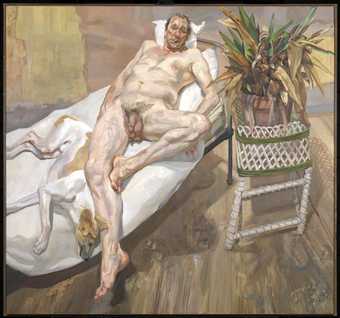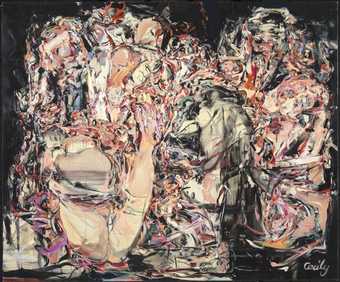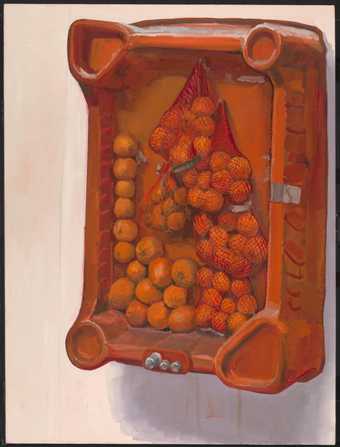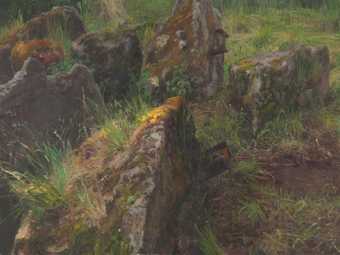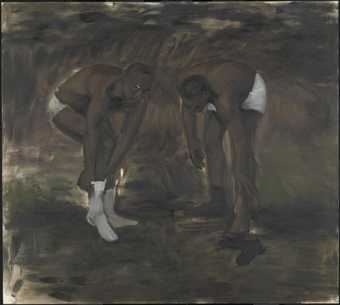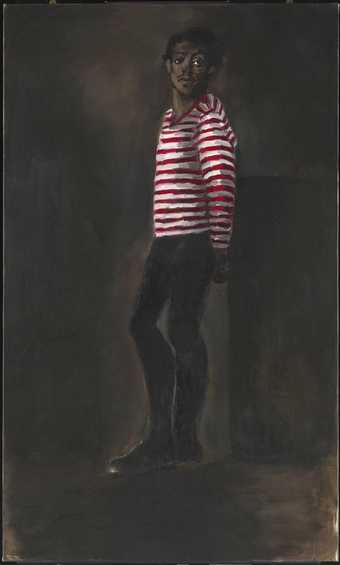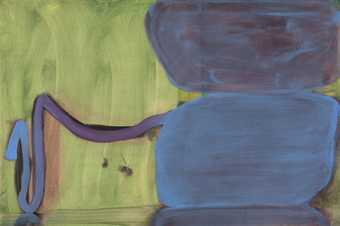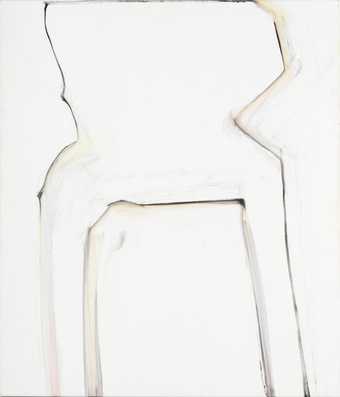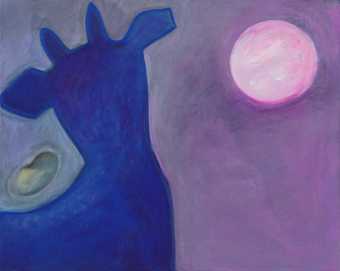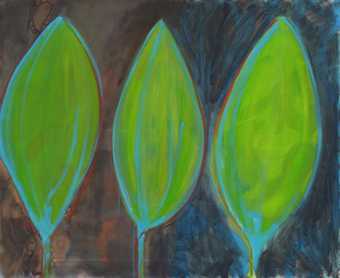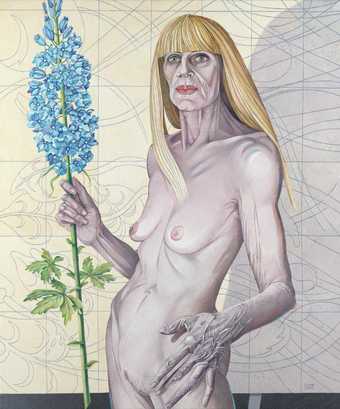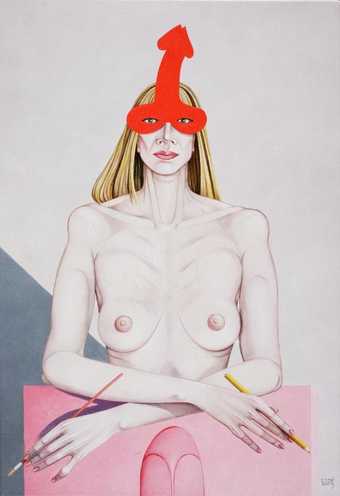
- Artist
- Lynette Yiadom-Boakye born 1977
- Medium
- Oil paint on canvas
- Dimensions
- Support: 501 × 404 mm
- Collection
- Tate
- Acquisition
- Purchased with funds provided by the European Collection Circle 2021
- Reference
- T15723
Summary
Razorbill 2020 is a small-scale oil painting of a single female figure with closely cropped hair. Her mouth is open as though caught mid-speech or song. Her upper body is clothed in near black, with a feathered ruffle at the collar. Her right forearm and left elbow rest on a tabletop. The motif of the carnivalesque ruff is one that reappears in Yiadom-Boakye’s work from 2009 onwards, in a number of paintings titled with bird names such as Les Corbeaux 2018, Greenfinch 2012 and Skylark 2010. Razorbill is closely related to these in its tones but is markedly different in its shift towards the looser brushwork and warmer palette that characterises Yiadom-Boakye’s work of 2020.
The fictitious figure is situated in an undefined abstract space devoid of reference to a particular place or time, leaving the historicity deliberately ambiguous. Yiadom-Boakye has explained: ‘I’ve always thought in terms of mark-making as a language and the painting itself as a language; it was never about describing an idea, or describing a time, or describing a situation, but allowing for a language that speaks of a feeling … Any form of explanation comes through sensation.’ (Conversation with Tate curator Isabella Maidment, 25 October 2019.)
The expression of the figure and the power of her gaze – which meets that of the viewer head on – are significant. The apparent warmth and directness of the facial expression, depicted as though captured candidly rather than formally posed, recall an earlier work, Black Allegiance to the Cunning 2018. Yiadom-Boakye has described her work in terms of the infinite possibilities of Blackness and Black life. She has said:
This idea of infinity, the idea of the impossible, of anything being possible, that’s what I think about most, that is the direction I’ve always wanted to move in … It isn’t so much about placing anyone in the canon as it is about saying that we’ve always been here, we’re always existed, self-sufficient, pre- and post- discovery, and in no way defined by who sees us. (Interview with Antwaun Sargent, ‘Lynette Yiadom-Boakye: Speaking through Painting’, Tate Etc, 13 October 2020, https://www.tate.org.uk/tate-etc/issue-50-autumn-2020/lynette-yiadom-boakye-antwaun-sargent-interview, accessed 16 January 2021.)
Razorbill belongs to a body of work that Yiadom-Boakye made during the Coronavirus pandemic in her home in London at the time of the first national lockdown in the spring of 2020. It was first exhibited in Yiadom-Boakye’s monographic survey Fly in League with the Night at Tate Britain, London, which opened on 2 December 2020. Yiadom-Boakye is both a painter and a writer of poetry and prose. She refers to her painting’s enigmatic titles as ‘an extra brushstroke’. The seabird to which the title Razorbill alludes is therefore not an explanation or direct reference but functions rather as an extension of her poetry and also a means of cataloguing paintings with a shared quality, in this instance by bird names. Yiadom-Boakye’s fictitious characters push themselves forwards into the viewer’s imagination almost like characters in a novel precisely because they are conjured through paint alone, always at a slight remove from reality.
Through its transposition of certain poses, colours and tones from the history of Western European portraiture, Yiadom-Boakye’s work enters into dialogue with a specific set of painters, notably Edouard Manet, Edgar Degas, Walter Sickert and Goya, artists she says she admires for their ‘devil may care way of working’ (Lynette Yiadom-Boakye, ‘The Artist’s Word as told to Naomi Beckwith’, Studio, Summer/Fall 2010, p.12). On the subject of her work’s relationship to the histories of painting, Yiadom-Boakye has said: ‘I don’t see myself harking back to history as [much as] speaking of my own mind, my own life, and my own time in one of the only ways that makes sense right now. Art is one of the few things that makes sense right now.’ (Interviewed by Natalie Bell and Massimiliano Gioni, in Lynette Yiadom-Boakye: Under Song for a Cipher, exhibition catalogue, New Museum, New York 2017, p.23.)
Further reading
Naomi Beckwith and Okwui Enwezor, Lynette Yiadom-Boakye: Any Number of Preoccupations, exhibition catalogue, The Studio Museum in Harlem, New York 2010.
Hilton Als, Amira Gad, Glenn Ligon, Lynette Yiadom-Boakye, Lynette Yiadom-Boakye: Verses After Dark, exhibition catalogue, Serpentine Gallery, London 2015.
Isabella Maidment and Andrea Schlieker (eds.), Lynette Yiadom-Boakye: Fly in League with the Night, exhibition catalogue, Tate Britain, London 2020.
Isabella Maidment
January 2021
Does this text contain inaccurate information or language that you feel we should improve or change? We would like to hear from you.
You might like
-
Lucian Freud David and Eli
2003–4 -
Cecily Brown Trouble in Paradise
1999 -
Bridget Riley Evoë 3
2003 -
Simon Ling Untitled
2008 -
Simon Ling Untitled
2010 -
Lynette Yiadom-Boakye The Generosity
2010 -
Lynette Yiadom-Boakye 10pm Saturday
2012 -
Rosalind Nashashibi In Vivian’s Garden
2016 -
Rosalind Nashashibi At My Post
2016 -
Jadé Fadojutimi I Present Your Royal Highness
2018 -
Rosalind Nashashibi Indifference
2017 -
Rosalind Nashashibi Untitled
2018 -
Caroline Coon Self with Delphinium Age 70
2016 -
Caroline Coon Self in Cock Mask
2003 -
Richard Hamilton The Saensbury Wing
1999–2000

